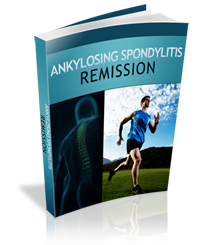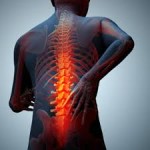 Individuals who suffer from Ankylosing Spondylitis will complain of chronic pain in the lower back and hips especially in the morning or after periods of inactivity. Early symptoms can also include stiffness in the lower back or hip area. As the disease progresses symptoms will get worse, improve or completely stop. Individuals also complain of pain in the tendons and ligaments which attach bones between the ribs and spine, joints in the hips, shoulders and knees as well as pain in the eyes. (2)
Individuals who suffer from Ankylosing Spondylitis will complain of chronic pain in the lower back and hips especially in the morning or after periods of inactivity. Early symptoms can also include stiffness in the lower back or hip area. As the disease progresses symptoms will get worse, improve or completely stop. Individuals also complain of pain in the tendons and ligaments which attach bones between the ribs and spine, joints in the hips, shoulders and knees as well as pain in the eyes. (2)
In the advanced stages of disease people will experience restricted expansion of the chest wall as the joints between the ribs in the spine are affected; chronic stooping, increase fatigue, weight loss, loss of appetite, bowel inflammation and eye inflammation are also symptoms of advanced disease.
At any time that you have pain in the joints or your back that is unexplained by previous trauma or athletic activity, it is important to see your primary care physician. Only they can help to accurately diagnose the condition and start proper treatment protocols which can reduce inflammation, swelling and progression of the disease. (3)
 Many researchers believe that Ankylosing Spondylitis has a genetic component. They have found that 90% of those who present with the disease are born with the HLA-B27 gene. Blood tests have been developed that can detect this marker which helps researchers to further understand the relationship between the gene and the disease. (4)
Many researchers believe that Ankylosing Spondylitis has a genetic component. They have found that 90% of those who present with the disease are born with the HLA-B27 gene. Blood tests have been developed that can detect this marker which helps researchers to further understand the relationship between the gene and the disease. (4)
However, this gene only appears to increase the tendency to develop the disease because other additional factors are necessary for the gene to be expressed or the disease to appear. Researchers have found that 7% of the total population in the United States carries the HLA-B27 gene and only 1% of the population has a diagnosis of Ankylosing Spondylitis. On the other hand, only 1.8% of the population in Lapland (a northern Scandinavian country) has the condition while 24% carries the gene.
At this time researchers have determined only three specific risk factors for the development of Ankylosing Spondylitis. These are sex (more males than females have the disease), age (between the ages of 20 and 40) and heredity (those who carry the gene may be more susceptible to developing the disease).
References:
(1) American Family Physician: Spondyloarthropathies
http://www.aafp.org/afp/2004/0615/p2853.html
(2) Therapeutic Clinical Risk Management: Update on the Treatment of Ankylosing Spondylitis
http://www.ncbi.nlm.nih.gov/pmc/articles/PMC2387283/
(3) Cleveland Clinic: Spondyloarthropathy
http://my.clevelandclinic.org/disorders/spondylitis/hic_spondyloarthropathy.aspx
(4) NHS Choices: Anykylosing Spondylitis – Complications
http://www.nhs.uk/Conditions/Ankylosing-spondylitis/Pages/Complications.aspx
| Advertisement | |
 |
|


Leave a Reply